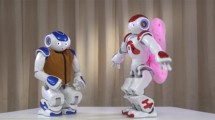Abstract
This paper presents an exploratory study in which children with autism spectrum disorder (ASD) interact with a NAO humanoid robot in an interactive football game scenario. The study was conducted during 4 sessions with three boys diagnosed with ASD. It observed improvements in therapeutic outcomes such as social interaction, communication, eye contact, joint attention and turn taking. Qualitative and quantitative analysis were conducted using various approaches such as video documenting, surveys and assessment scales. In order to establish the efficacy of the study children interacted with their typically developing peers and parents post intervention to relate skills learned in robot-human setting to human-human setting. The quantitative results gathered and analyzed from pre and post implementation showed an increased in execution and duration of target behaviors. Manual coding and qualitative analysis of videos also verified that the proposed robot mediated play setting demonstrated improvements in social development of children with ASD in areas of communicative competence, turn taking, social interaction and proxemics and eye contact.
Access this chapter
Tax calculation will be finalised at checkout
Purchases are for personal use only
Similar content being viewed by others
References
Allen, D.A.: Autistic spectrum disorders: clinical presentation in preschool children. J. Child Neurol. 3, 48–56 (1988)
Lovaas, O.I.: Behavioral treatment & normal educational and intellectual functioning in young autistic children. J. Consult. Clin. Psychol. 55(1), 3–9 (1987)
Feil-Seifer, D., Mataric, M.: Robot-assisted therapy for children with autism spectrum disorders. In: ACM Proceedings of the 7th International Conference on Interaction Design and Children, pp. 49–52 (2008)
Scassellati, B., Admoni, H., Mataric, M.: Robots for use in autism research. Annu. Rev. Biomed. Eng. 14, 275–294 (2012)
Cabibihan, J.-J., Javed, H., Ang Jr., M., Aljunied, S.M.: Why robots? a survey on the roles and benefits of social robots in the therapy of children with autism. Soc. Robot. 5(4), 593–618 (2013)
Robins, B., Dautenhahn, K., te Boekhorst, R., Billard, A.: Robotic assistants in therapy and education of children with autism: can a small humanoid robot help encourage social interaction skills? Univers. Access. Inf. Soc. 4(2), 105–120 (2005)
Robins, B., Dautenhahn, K.: The role of the experimenter in hri research—a case study evaluation of children with autism iteracting with a robotic toy. In: Proceedings of the 15th IEEE International Symposium on Robot and Human Interactive Communication, pp. 646–651. IEEE Press, Piscataway (2006)
Howlin, P.: An overview of social behaviour in autism. In: Social Behaviour in Autism, pp. 103–132. Plenum, New York (1986)
Wainer, J., Ferrari, E., Dautenhahn, K.: Robins B The effectiveness of using a robotics class to foster collaboration among groups of children with autism in an exploratory study. Pers Ubiquitous Comput 14(5), 445–455 (2010)
Weiss, M.J., Harris, S.L.: Teaching social skills to people with autism. Behav. Modif. 25, 785–802 (2001)
Bauminger, N., Solomon, M., Aviezer, A., Heung, K., Brown, J., Rogers, S.J.: Friendships in high-functioning children with autism spectrum disorder: Mixed and non-mixed dyads. J. Autism Dev. Disord. 38, 1211–1229 (2008)
Bauminger, N., Shulman, C., Agam, G.: Peer interaction and loneliness in high-functioning children with autism. J. Autism Dev. Disord. 33, 489–507 (2003)
Dautenhahn, K., Werry, I.: Towards interactive robots in autism therapy: Background motivation, and challenges. Pragmat. Cogn. 12, 1–35 (2004)
Robins, B., Dautenhahn, K., Dubowski, J.: Does appearance matter in the interaction of children with autism with a humanoid robot? Interact. Stud. 7, 509–512 (2006)
Bird, G., Leighton, J., Press, C., Heyes, C.: Intact automatic imitation of human & robot actions in autism spectrum disorders. Proc. Biol. Sci. 274, 3027–3031 (2007)
Pierno, A.C., Mari, M., Lusher, D., Castiello, U.: Robotic movement elicits visuomotor priming in children with autism. Neuropsychologia 46, 448–454 (2008). [PubMed: 17920641]
Bethel, C., Murphy, R.: Review of human studies methods in HRI and recommendations. Int. J. Social Robot. 2, 347–359 (2010)
Harris, S.L., Delmolino, L.: Applied behavior analysis: its application in the treatment of autism and related disorders in young children. Infants Young Child. 14, 11–18 (2002)
Acknowledgments
We are grateful to Picture Autism for facilitating this study and the parents and children for their participation.
Author information
Authors and Affiliations
Corresponding author
Editor information
Editors and Affiliations
Rights and permissions
Copyright information
© 2016 Springer International Publishing AG
About this paper
Cite this paper
Tariq, S., Baber, S., Ashfaq, A., Ayaz, Y., Naveed, M., Mohsin, S. (2016). Interactive Therapy Approach Through Collaborative Physical Play Between a Socially Assistive Humanoid Robot and Children with Autism Spectrum Disorder. In: Agah, A., Cabibihan, JJ., Howard, A., Salichs, M., He, H. (eds) Social Robotics. ICSR 2016. Lecture Notes in Computer Science(), vol 9979. Springer, Cham. https://doi.org/10.1007/978-3-319-47437-3_55
Download citation
DOI: https://doi.org/10.1007/978-3-319-47437-3_55
Published:
Publisher Name: Springer, Cham
Print ISBN: 978-3-319-47436-6
Online ISBN: 978-3-319-47437-3
eBook Packages: Computer ScienceComputer Science (R0)




